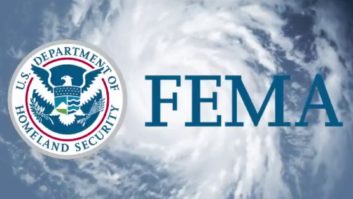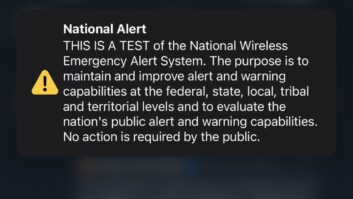ANCHORAGE, Alaska A test of the Emergency Alert System that included the first planned activation of the Emergency Action Notification event code was likely just the first of several exercises the Federal Emergency Management Agency will take, seeking data to help plug coverage gaps in the planned next-gen EAS.
The EAN is the activation code that would allow the president of the United States to address the nation directly via broadcast radio stations, TV stations and cable outlets during a national emergency.
The Alaskan test in January was observed by a large contingent of FEMA and Federal Communications Commission personnel and was deemed a success by most involved despite a few glitches. The Alaska Division of Homeland Security and Emergency Management, the Alaska Broadcasters Association, the Federal Communications Commission and FEMA officials coordinated the event.

The Alaska Broadcasters Association provided this image for TV and cable systems to use during the test. The overall success of the exercise will be measured in part by a statewide followup survey of radio and TV broadcasters by the Alaska Broadcasters Association.
The FCC has since proposed an annual nationwide test of the national alert capability of EAS in a subsequent rulemaking proposal and is asking for comments to EB Docket 04-296 (Radio World, Feb. 1).
Interpretation
There are 104 radio stations and 26 TV stations in Alaska, all of which must participate in EAS and be able to air an EAN. Planners said the January test involved sending a test EAN data alert issued by the FEMA Operations Center in Washington down the daisy chain from the state’s one Primary Entry Point station to all radio stations.
Among factors the agencies tracked were audio levels and whether encoder/decoders functioned properly. The EAN test was limited to Alaska by sending the test to only that state’s PEP station. Planners were able to contain the test to the state because of its relative isolation from the lower 48.
The test produced minor technical difficulties, most often with equipment or audio levels, according to observers.
For instance, one of the state’s largest cable providers failed to receive the EAN message initially. At least several radio and television stations allowed the three-minute test message to pass through twice because of a programming error in their EAS encoder/decoders, according to Darlene Simono, executive director of the Alaska Broadcasters Association.
Broadcast stations and cable operators across Alaska employ a variety of encoder/decoder makes and models. One of the key goals of the test was to see how the universe of installed equipment handled the EAN.
Simono said DASDEC model encoder/decoders malfunctioned at several stations because of a “programming malfunction within the unit.”
The manufacturer of the PC-based product, Digital Alert Systems, a division of Monroe Electronics Inc., agreed with Simono’s assessment but said its coder/decoder is programmed not to ignore any EAN alert, even duplicates.
“The (FCC’s) Part 11 rules really do not address how to handle EAN alerts,” said Jim Heminway, vice president and general manager of Monroe Electronics. “The FCC has left that interpretation up to the manufacturers. It’s really not defined. That’s why we have been very supportive of a national EAN test, to uncover situations just like this and open up discussion of how we should handle them.”
In its recent announcement of a proposed national test, the FCC noted concerns about how EANs are interpreted by station hardware. It said encoder/decoder manufacturers may have programmed their devices to receive and transmit EANs in different ways, which may affect the ability of some devices to relay an EAN properly.
FEMA also added a 15-minute duration to the header of the EAN alert, which “should not have occurred,” Heminway said.
State emergency officials said the Alaska test demonstrated the “daisy chain” nature of the current EAS architecture, which has been criticized for possible “single point of failure” concerns.
‘Audio levels a challenge’
“We had some issues of course. We had six smaller markets that never did receive the alert message. That was unacceptable. Audio levels were a challenge,” said Bryan Fisher, chief of operations at the Alaska Division of Homeland Security and Emergency Management.
“However, that is why we run tests. This gives us a chance to go and remedy some of those issues.”
Dennis Bookey, co-chair of Alaska’s State Emergency Communications Committee, was aware of only one radio station reporting audio level difficulties.
“The audio level in that case was so low it didn’t trigger the test, but that was the result of his level setting and not characteristic of the exercise.”
Fisher credited Alaskan broadcasters for their preparation and participation. Broadcasters ran public service announcements for several weeks prior to the EAN alert to help avoid public panic.
Alaska was chosen as site of the test because of its “geographic location, leadership and experience in transmitting severe weather alerts,” stated Jamie Barnett, chief of the FCC’s Public Safety and Homeland Security Bureau.
Barnett stated afterwards that results would be evaluated and used to improve the system.
Many within the EAS community were pleased to see the Alaskan EAN activation and credit FEMA for taking proactive steps by running it, said Gary Timm, broadcast chairman of the State Emergency Communications Committee for Wisconsin.
“A lot of us have been riding both FEMA and the FCC about never having done an EAN test. FEMA may have realized with what happened in Illinois several years back that testing was needed.”
Timm cited an incident in 2007 when a closed-circuit test of a presidential alert by FEMA inadvertently was relayed through EAS and affected hundreds of stations across the Midwest, including stations in Illinois, Indiana and Michigan. According to the FCC, some EAS participants’ equipment did not pass the alert. The commission also cited numerous anecdotal reports of problems with EAS delivery architectures and PEP station readiness.
Timm listened to January’s EAN alert on the online stream of public station KSKA(FM) in Anchorage. He said FEMA’s testing indicates a desire to “get it right” when the new Integrated Public Alert and Warning System is launched.
Adrienne Abbott, chair of the State Emergency Communications Committee for Nevada and a field engineer for the Nevada Broadcasters Association, said, “The [Alaskan] test was a success if for no other reason than it started a lot of discussion among broadcasters about how EAS would work in the event of a national emergency and whether the EAN event code would work as theorized by the FCC and FEMA.”










